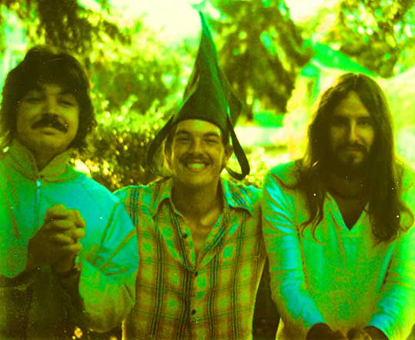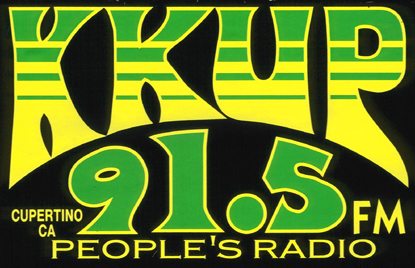| |

Don (left) in 1971 with Roots Of
Madness and an "I have come to fix your washing machine" moustache...
happened and
there was a mini tidal wave of Roots Of Madness interest then, especially in
Japan. To make this long story even longer, I began my own solo home taping
exploits in about 1976 . In 1984 after I heard about the international home
taping scene from reading a copy of OP Magazine I organized my previous solo
tapes into albums and started up my little catalog, Lonely Whistle Music. I
already had a radio show and in 1985 I solidified the format into all home
recordings/independent music and it has remained that way until now. Along
the way I have made about 50 solo and collaboration albums. All listed in my
catalog by the way (click on the logo)...

MM:
Your enthusiasm for music was quite boundless; aside from running your own
Lonely Whistle Music label and KFR distribution, you’d also been
broadcasting for a good number of years, as you’ve said, this being your “No
Pigeonholes” radioshow. For those not in the know, this went out on KKUP (I
still have my bumper sticker!) in the San Francisco Bay area, alternate
Sundays, which makes you realise how different things were with the
limitations of a pre-internet Planet Earth! The published blurb on your show
stated that you aimed to play something from EVERY tape you
got (the first tracks you ever played from me were MMATT’s “Acidic Heaven”
and Internal Autonomy’s “L.S.D.” – spot the connection!), which was
ambitious, to say the least, and there was a word that came up frequently in
regard to the music you preferred to receive; “hometapers”. This word
clearly held a great significance for you, can you explain what it meant to
you and what it was about the “hometaper” phenomenon that you felt so
important?

See? Told you I still had my KKUP
bumper sticker! |
DC:
“Home
Tapers” were simply the group of people worldwide who were taping their
original music at home, and sending it out on cassette tape to friends,
contacts and the various magazines who were covering this scene like Option,
Sound Choice, Factsheet Five, Autoreverse and Gajoob. This period was from
approximately 1983 to around 1998 although there is no really defined exact
period. When CDs started appearing the steam was let out of the Cassette
bag and the scene started to break up. Plus, most of the publications that
covered this narrow niche folded up as well.
MM: No argument there.
Back in the day, you were certainly a great supporter of MMATT, for which we
shall be eternally grateful, of course, doing U.S. releases of a number of
our albums. But beyond Lonely Whistle Music and KFR, I recall you also had a
bootleg label called Loose Caboose back then. I remember having quite a
discussion with Stephen Parsons about the morality of bootlegs when we
visited him in Swindon in the summer of 1991. I was almost 100% opposed to
the notion in those days, whilst Stephen happily sold them. Mind you, my
moral outrage vanished when he told me he had a good Kate Bush bootleg, I
instead found myself taking £2 out of my pocket and buying one.
Surprisingly, I felt none too guilty and that Kate could probably afford the
loss. But still believed it to be wrong. That strange duality of human
morals, eh? What were your own feelings on bootlegs at the time, did you
feel an artiste should have absolute and eternal control over their own
output, or maybe some limits of compensation for recorded works wouldn’t
seem unreasonable?
DC:
For one
thing, I never, ever sold any bootlegs. It was all trade only.
Once, I got a threatening letter from the R.I.A.A. (Recording Industry
Association of America) after someone found out they could get a Grateful
Dead tape from me, but I needed $2 for postage to send it back to them. They
finked me out to the authorities. I folded up Loose Caboose not long after,
although I secretly reappeared years later on the internet in different
guise. The idea is that real “fans” want further research on their
particular musical heroes. In my mind, real fans almost always support their
favorite artists and want the original quality offerings and purchase their
material. I always have and still do For me, I only offered live and
unavailable material culled generally from radio shows worldwide. Many
record companies have suppressed valuable live and rare material for a
variety of reasons. I thought that fans should be able to hear these things.
Plus, it gave me stuff to trade for artists I had an interest in.
MM:
Also during our visit with Stephen, he’d told us he would soon be moving to
the States and was looking for someone to take over KFR UK. Having talked to
him extensively of all the ins and outs of running an operation like that, I
was certainly interested. I think Stephen was moving to Palos Verdes in
California and hoped to help you running KFR U.S.A. while he was out there.
I don’t know if all of that came to fruition, but if so, perhaps you would
be so kind as to share a few of your memories of those days?
DC:
That is
interesting because I only remember that vaguely now. I think it had
something to do with the woman Jennifer whom I mentioned earlier. That
didn’t work out so Stephen never moved to the USA as far as I know. I was
lucky to meet him and his family in Swindon though in 1991. To me, KFR was
never a big part of what I did. Most of my activities were radio based and
of course the endless tape trades with other like minded tapers around the
world. It was easy to get a tape in trade when I mentioned the radio
exposure. In fact, after awhile many people no longer even wished for one of
my tapes in trade. They only wanted promo for their “product”. This was not
my idea of the community I wanted to be part of but I decided early on that
I would not judge people’s intentions or motives.
MM:
Ultimately, KFR UK went to one of Stephen’s work colleagues from Our Price,
so I decided instead to start a label of my own, originally intended to be
called The Mmattrix Distribution |
|